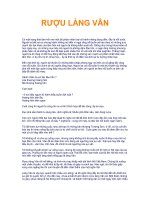Tài liệu Cosmetics Information Center doc
Bạn đang xem bản rút gọn của tài liệu. Xem và tải ngay bản đầy đủ của tài liệu tại đây (97.09 KB, 8 trang )
Welcome to the
Freedom Village Malls
Cosmetics
Information Center
/>
.
.
Cosmetics and Your Health by womenshealth.gov
Provides answers to the following questions:
What are cosmetics? How are they different from over-the-counter (OTC) drugs?
What's in cosmetics?
What is the role of the Food and Drug Administration (FDA) in the cosmetic
industry?
Are cosmetics safe?
How can I protect myself against the dangers of cosmetics?
What are "cosmeceuticals?"
How long do cosmetics last?
What are hypoallergenic cosmetics?
Can cosmetics cause acne?
Are tattoos and permanent make-up safe?
Are cosmetic products with alpha hydroxy acids safe?
What precautions should I follow when using AHA products?
Are hair dyes safe?
What precautions should I take when I dye my hair?
Are lead acetates safe in hair dyes?
Is it safe to dye my hair when I'm pregnant?
Page
1
of
1
Freedom Village Malls: Cosmetics Information Center
9/6/2006
/>F R E Q U E N T LY A S K E D Q U E S T I O N S
WomensHealth.gov
1-800-994-9662
TDD: 888-220-5446
page 1
Cosmetics and
Your Health
Q: What are cosmetics? How are
they different from over-the-
counter (OTC) drugs?
A: Cosmetics are put on the body to:
●
cleanse it
●
make it beautiful
●
make it attractive
●
change its appearance or the way it
looks
Cosmetic products include:
●
skin creams
●
lotions
●
perfumes
●
lipsticks
●
fingernail polishes
●
eye and face make-up products
●
permanent waves
●
hair dyes
●
toothpastes
●
deodorants
Unlike drugs, which are used to treat or
prevent disease in the body, cosmetics
do not change or affect the body's
structure or functions.
Q: What's in cosmetics?
A: Fragrances and preservatives are the
main ingredients in cosmetics.
Fragrances are the most common cause
of skin problems. More than 5,000
different kinds are used in products.
Products marked “fragrance-free” or
“without perfume” means that no
fragrances have been added to make the
product smell good.
Preservatives in cosmetics are the
second most common cause of skin
problems. They prevent bacteria and
fungus from growing in the product
and protect products from damage
caused by air or light. But preservatives
can also cause the skin to become
irritated and infected. Some examples
of preservatives are:
●
paraben
●
imidazolidinyl urea
●
Quaternium-15
●
DMDM hydantoin
●
phenoxyethanol
●
formaldehyde
The ingredients below cannot be used,
or their use is limited, in cosmetics.
They may cause cancer or other serious
health problems.
●
bithionol
●
mercury compounds
●
vinyl chloride
●
halogenated salicyanilides
●
zirconium complexes in aerosol
sprays
●
chloroform
●
methylene chloride
●
chlorof luorocarbon propellants
●
hexachlorophene
N A T I O N A L W O M E N ’ S H E A L T H I N F O R M AT I O N C E N T E R
U.S. Department of Health and Human Services, Office on Women’s Health
F R E Q U E N T LY A S K E D Q U E S T I O N S
WomensHealth.gov
1-800-994-9662
TDD: 888-220-5446
page 2
Q: What is the role of the Food Q: Are cosmetics safe?
and Drug Administration (FDA) A: Yes, for the most part. Serious
in the cosmetic industry?
problems from cosmetics are rare. But
A: A cosmetic maker can sell products
without FDA approval. FDA does not
review or approve cosmetics, or their
ingredients, before they are sold to the
public. But FDA urges cosmetic makers
to do whatever tests are needed to
prove their products are safe. Cosmetics
makers must put a warning statement
on the front labels of products that have
not been safety testing, which reads,
“WARNING—The safety of this
product has not been determined.”
sometimes problems can happen.
The most common injury from
cosmetics is from scratching the eye
with a mascara wand. Eye infections
can result if the scratches go untreated.
These infections can lead to ulcers on
the cornea (clear covering of the eye),
loss of lashes, or even blindness. To
play it safe, never try to apply mascara
while riding in a car, bus, train, or
plane.
Sharing make-up can also lead to
FDA does require safety testing for
color additives used in cosmetics.
Cosmetics may only contain approved
and certified colors. You'll find FD&C,
D&C, or external D&C listed on
cosmetic labels.
serious problems. Cosmetic brushes
and sponges pick up bacteria from the
skin. And if you moisten brushes with
saliva, the problem can be worse.
Washing your hands before using
make-up will help prevent this
●
FD&C – color that can be used only
problem.
in foods, drugs, and cosmetics
Sleeping while wearing eye make-up
●
D&C – color that can be used only
can cause problems too. If mascara
in drugs and cosmetics
f lakes into your eyes while you sleep,
you might wake up with itching,
●
external D&C – color that can be
bloodshot eyes, infections, or eye
used only in drugs applied to the
scratches. So be sure to remove all
surface of the skin and cosmetics
make-up before going to bed.
A cosmetic maker also does not have to
Cosmetic products that come in aerosol
report product injuries. FDA collects
this information on a voluntary basis
only. Cosmetic makers that want to be
a part of this program send reports to
the FDA.
Product recalls are voluntary actions
taken by cosmetic makers too. FDA
cannot require cosmetics recalls. But
FDA does monitor cosmetic makers
that do a recall. FDA must first prove in
court that a cosmetic product is a
danger or somehow breaks the law
containers also can be a hazard. For
example, it is dangerous to use aerosol
hairspray near heat, fire, or while
smoking. Until hairspray is fully dry, it
can catch on fire and cause serious
burns. Fires related to hairsprays have
caused injuries and death. Aerosol
sprays or powders also can cause lung
damage if they are deeply inhaled into
the lungs.
To find out more about cosmetic safety,
check out the FDA's Cosmetics True or
before it can be taken off the market.
False Quiz at
N AT I O N A L WO M E N ’ S H E A LT H I N F O R M AT I O N C E N T E R
U.S. Department of Health and Human Services, Office on Women’s Health
F R E Q U E N T LY A S K E D Q U E S T I O N S
~dms/costf.html and find out how and kohl (color additive that
much you really know! contains lead salts and is still used in
eye cosmetics in other countries).
Q: How can I protect myself
Be sure to keep kohl away from
against the dangers of
children. It may cause lead
WomensHealth.gov
poisoning.
cosmetics?
1-800-994-9662
●
Never drive and put on make-up.
TDD: 888-220-5446
Not only does this make driving a
Q: What are “cosmeceuticals?”
danger, hitting a bump in the road
A: Some products can be both cosmetics
and scratching your eyeball can
and drugs. This may happen when a
cause serious eye injury.
product has two uses. For example, a
●
Never share make-up. Always use a
shampoo is a cosmetic because it’s used
new sponge when trying products at
to clean the hair. But, an anti-dandruff
a store. Insist that salespersons clean
treatment is a drug because it's used to
container openings with alcohol
treat dandruff. So an antidandruff
before applying to your skin.
shampoo is both a cosmetic and a drug.
Other examples are:
●
Keep make-up containers closed
tight when not in use.
●
toothpastes that contain f luoride
●
deodorants that are also
●
Keep make-up out of the sun and
heat. Light and heat can kill the
preservatives that help to fight
bacteria. Don’t keep cosmetics in a
antiperspirants
●
moisturizers and make-up that
provide sun protection
hot car for a long time.
These products must meet the
●
Don’t use cosmetics if you have an
eye infection, such as pinkeye.
Throw away any make-up you were
using when you first found the
problem.
standards for both cosmetics (color
additives) and drugs.
Some cosmetic makers use the term
“cosmeceutical” to refer to products
that have drug-like benefits. FDA does
●
Never add liquid to a product unless
not recognize this term. A product can
the label tells you to do so.
be a drug, a cosmetic, or a combination
of both. But the term “cosmeceutical”
●
Throw away any make-up if the
has no meaning under the law.
color changes, or it starts to smell.
While drugs are reviewed and approved
●
Never use aerosol sprays near heat
by FDA, FDA does not approve
or while smoking, because they can
cosmetics. If a product acts like a drug,
catch on fire.
FDA must approve it as a drug.
●
Don’t deeply inhale hairsprays or
powders. This can cause lung
Q: How long do cosmetics last?
damage.
A: You may not be able to use eye make-
●
Avoid color additives that are not
up, such as mascara, eyeliner, and eye
approved for use in the eye area,
shadow for as long as other products.
such as “permanent” eyelash tints
This is because of the risk of eye
page 3
N AT I O N A L WO M E N ’ S H E A LT H I N F O R M AT I O N C E N T E R
U.S. Department of Health and Human Services, Office on Women’s Health
WomensHealth.gov
1-800-994-9662
TDD: 888-220-5446
page 4
F
R E Q U E N T LY A S K E D Q U E S T I O N S
infection. Some experts recommend
replacing mascara three months after
purchase. If mascara becomes dry,
throw it away. Don’t add water or, even
worse, saliva to moisten it. That will
sheep wool is found in many lotions.
But it's a common cause of allergies
too.
Q: Can cosmetics cause acne?
bring bacteria into the product.
A: Some skin and hair care products can
You may also need to watch certain “all
cause acne. To help prevent and control
natural” products that contain
substances taken from plants. These
products may be more at risk for
bacteria. Since these products contain
no preservatives or have non-traditional
ones, your risk of infection may be
greater.
acne f lare-ups, take good care of your
skin. For example, use a mild soap or
cleanser to gently wash your face twice
a day. Choose “non-comedogenic”
make-up and hair care products. This
means that they don't close up the
pores.
If you don’t store these products as
directed, they may expire before the
Q: Are tattoos and permanent
expiration date. For example, cosmetics
make-up safe?
stored in high heat may go bad faster
than the expiration date. On the other
A: FDA is looking into the safety of
hand, products stored the way they
tattoos and permanent make-up since
should be can be safely used until they
they are now more popular. The inks,
expire.
or dyes, used for tattoos are color
additives. Right now, no color additives
have been approved for tattoos,
Q: What are hypoallergenic
including those used in permanent
cosmetics?
make-up.
A: Hypoallergenic (hy-po-al-ler-gen-ic)
cosmetics are products that makers
claim cause fewer allergic reactions than
other products. Women with sensitive
You should be aware of these risks of
tattoos and permanent make-up:
●
Tattoo needles and supplies can
skin, and even those with "normal"
transmit diseases, such as hepatitis C
skin, may think these products will be
and HIV. Be sure all needles and
gentler. But there are no federal
supplies are sterile before they are
standards for using the term
hypoallergenic. The term can mean
whatever a company wants it to mean.
Cosmetic makers do not have to prove
their claims to the FDA.
used on you.
●
Tattoos and permanent make-up are
not easy to take off. Removal may
cause a permanent change in color.
Some products that have “natural”
ingredients can cause allergic reactions.
If you have an allergy to certain plants
●
Think carefully before getting a
tattoo. You could have an allergic
reaction.
●
You cannot make blood donations
or animals, you could have an allergic
reaction to cosmetics with those things
for a year after getting a tattoo or
in them. For example, lanolin from
permanent make-up.
N AT I O N A L WO M E N ’ S H E A LT H I N F O R M AT I O N C E N T E R
U.S. Department of Health and Human Services, Office on Women’s Health
F R E Q U E N T LY A S K E D Q U E S T I O N S
WomensHealth.gov
1-800-994-9662
TDD: 888-220-5446
page 5
Q: Are cosmetic products with
protection factor) of at least 15.
alpha hydroxy acids safe?
Wear a hat with a brim. Cover up
A: Alpha hydroxy acids (AHAs) come
from fruit and milk sugars. They are
found in many creams and lotions.
Many people buy products with AHAs,
because they claim to reduce wrinkles,
spots, sun-damaged skin, and other
with lightweight, loose-fitting,
long-sleeved shirts, and pants.
●
Buy products with good label
information:
●
a list of ingredients to see which
AHA or other chemical acids are in
signs of aging. Some studies suggest
the product
they may work.
But are these products safe? FDA has
received reports of reactions in people
using AHA products. Their complaints
●
the name and address of the maker
●
a statement about the product's
AHA and pH levels
include:
The first two have to be on the label.
●
severe redness
The third is one is by choice. You can
●
swelling (especially in the area of the
call or write the maker to find about a
eyes)
product's AHA and pH levels.
●
burning
●
Buy only products with an AHA
level of 10 percent or less and a pH
●
blistering
of 3.5 or more.
●
bleeding
●
Test a small area of skin to see if it is
●
rash
sensitive to any AHA product before
using a lot of it.
●
itching
●
Stop using the product right away if
●
skin discoloration
you have a reaction, such as stinging,
AHAs may also increase your skin's risk
redness, or bleeding.
of sunburn.
To find out if a product contains an
AHA, look on the list of ingredients.
By law, all cosmetics have ingredients
on their outer label. AHAs may be
called other names, like glycolic acid
and lactic acid.
●
Talk with your doctor or
dermatologist (a doctor that treats
skin problems) if you have a
problem. You also can report your
reaction to the FDA. Write to:
Office of Cosmetics and Colors
(HFS-106), 5100 Paint Branch
Parkway, College Park, MD 20740-
Q: What precautions should I
3835. Or you can call them at (202)
follow when using AHA
401-9725.
products?
A: If you want to use AHA products,
Q: Are hair dyes safe?
follow these safety tips:
A: The decision to change your hair color
●
Always protect your skin before
going out during the day. Use a
sunscreen with a SPF (sun
may be a hard one. Some studies have
linked hair dyes with a higher risk of
certain cancers, while other studies
N AT I O N A L WO M E N ’ S H E A LT H I N F O R M AT I O N C E N T E R
U.S. Department of Health and Human Services, Office on Women’s Health
WomensHealth.gov
1-800-994-9662
TDD: 888-220-5446
page 6
F
R E Q U E N T LY A S K E D Q U E S T I O N S
have not found this link. Most hair dyes
●
Carefully follow the directions in
also don’t have to go through safety the hair dye package.
testing that other cosmetic color
●
Never mix different hair dye
additives do before hitting store shelves.
products.
Women are often on their own trying
to figure out whether hair dyes are safe.
●
Be sure to do a patch test for allergic
reactions before applying the dye to
When hair dyes first came out, the
your hair. Almost all hair dye
main ingredient in coal-tar hair dye
products include instructions for
caused allergic reactions in some
doing a patch test. It’s important to
people. Most hair dyes are now made
do this each time you dye your hair.
from petroleum sources. But FDA still
Your hairdresser should also do the
considers them to be coal-tar dyes. This
is because they have some of the same
compounds found in these older dyes.
patch test before dyeing your hair.
To test, put a dab of hair dye behind
your ear, and don’t wash it off for
Cosmetic makers have stopped using
things known to cause cancer in
animals. For example, 4-methoxy-m-
phenylenediamine (4MMPD) or 4-
methoxy-m-phenylenediamine sulfate
(4MMPD sulfate) are no longer used.
But chemicals made almost the same
way have replaced some of the cancer-
two days. If you don’t have any signs
of allergic reaction, such as itching,
burning, or redness at the test spot,
you can be somewhat sure that you
won't have a reaction to the dye
applied to your hair. If you do react
to the patch test, do the same test
causing compounds. Some experts feel
that these newer ingredients aren't very
different from the things they're
with different brands or colors until
you find one to which you're not
allergic.
replacing.
●
Never dye your eyebrows or
eyelashes. An allergic reaction to dye
Experts suggest that you may reduce
could cause swelling or increase risk
your risk of cancer by using less hair
dye over time. You may also reduce
you risk by not dyeing your hair until it
of infection in the eye area. This can
harm the eye and even cause
blindness. Spilling dye into the eye
starts to gray.
by accident could also cause
permanent damage. FDA bans the
Q: What precautions should I take
when I dye my hair?
You should follow these safety tips when
dyeing your hair:
use of hair dyes for eyelash and
eyebrow tinting or dyeing even in
beauty salons.
●
Don't leave the dye on your head
Q: Are lead acetates safe in hair
any longer than needed.
dyes?
●
Rinse your scalp thoroughly with
A: Lead acetate is used as a color additive
water after use.
in “progressive” hair dye products.
●
Wear gloves when applying hair dye.
These products are put on over a
period of time to produce a gradual
N AT I O N A L WO M E N ’ S H E A LT H I N F O R M AT I O N C E N T E R
U.S. Department of Health and Human Services, Office on Women’s Health
F R E Q U E N T LY A S K E D Q U E S T I O N S
coloring effect. You can safely use these
Q: Is it safe to dye my hair when
products if you follow the directions
I'm pregnant?
carefully. This warning statement must
A: We don’t know much about the safety
appear on the product labels of lead
of hair dyes during pregnancy. It's likely
acetate hair dyes:
that when you apply hair dye, only a
WomensHealth.gov
“Caution: Contains lead acetate. For small amount is absorbed into your
1-800-994-9662
external use only. Keep this product system. So very little chemicals, if any,
TDD: 888-220-5446
out of children’s reach. Do not use on
cut or abraded scalp. If skin irritation
develops, discontinue use. Do not use
to color mustaches, eyelashes,
eyebrows, or hair on parts of the body
other than the scalp. Do not get in
eyes. Follow instructions carefully and
wash hands thoroughly after use.”
would be able to get to your baby. In
the few animal and human studies that
have been done, no changes were seen
in the developing baby. Talk with your
doctor if you have questions or
concerns.
■
Phone: (888) 463-6332 (Consumer
OPHS, HHS
Phone: (888) 723-3366
(AAD)
For More Information…
For more information on cosmetics or hair dye, contact the National Women’s Health
Information Center at 1-800-994-9662 or the following organizations:
Food and Drug Administration
(FDA), OPHS, HHS
Information)
Internet Address:
Off ice of Cosmetics and Colors
Automated Information Line, FDA,
Internet Address:
American Academy of Dermatology
Phone: (888) 462-3376
Internet Address:
Mayo Foundation for Medical
Education and Research Skin Center
Phone: (480) 301-8000
Internet Address:
This FAQ has been expert reviewed by Dr. Sandra I. Read, Department of Dermatology,
Georgetown University, Washington, D.C.
November 2004
page 7
N AT I O N A L WO M E N ’ S H E A LT H I N F O R M AT I O N C E N T E R
U.S. Department of Health and Human Services, Office on Women’s Health









